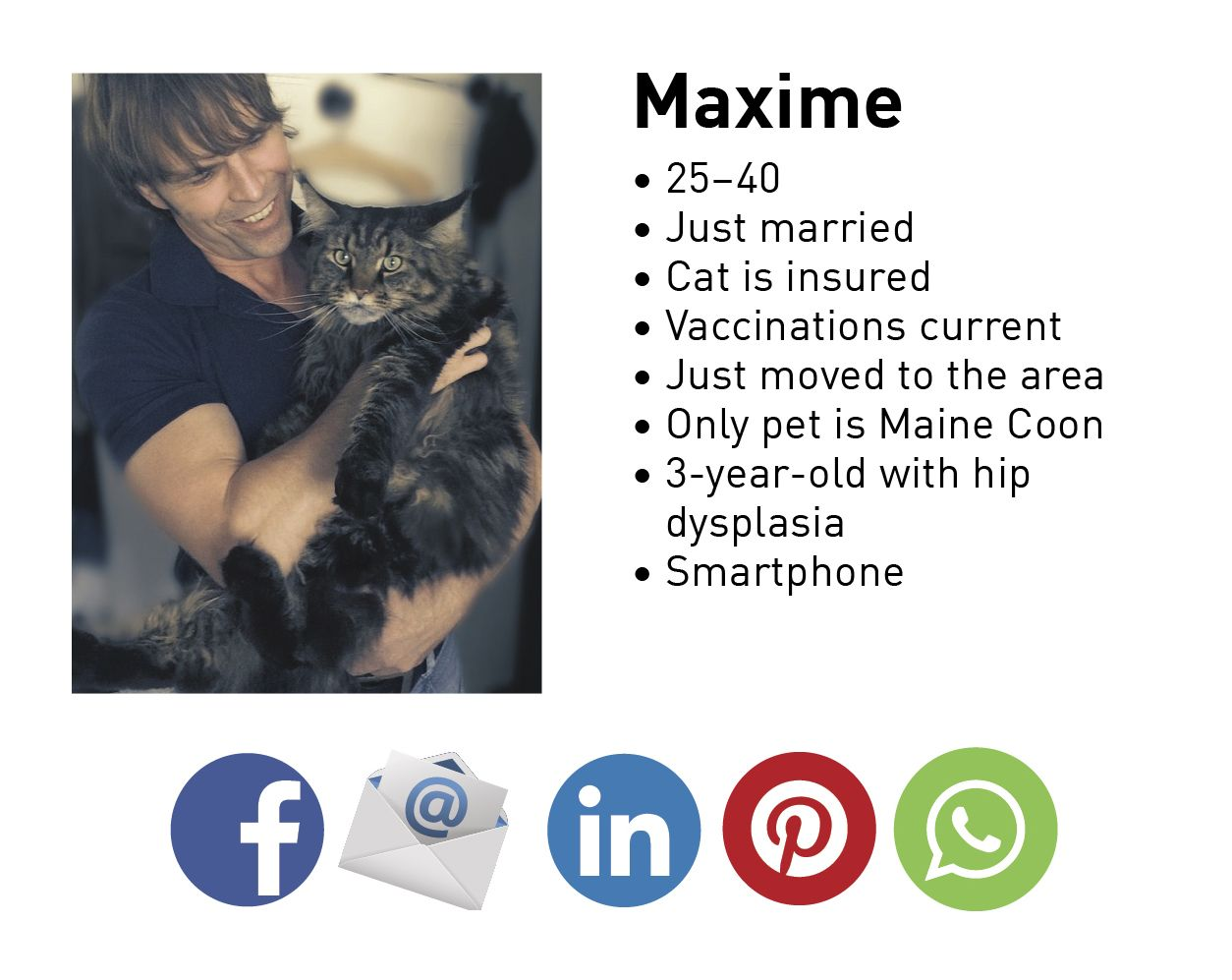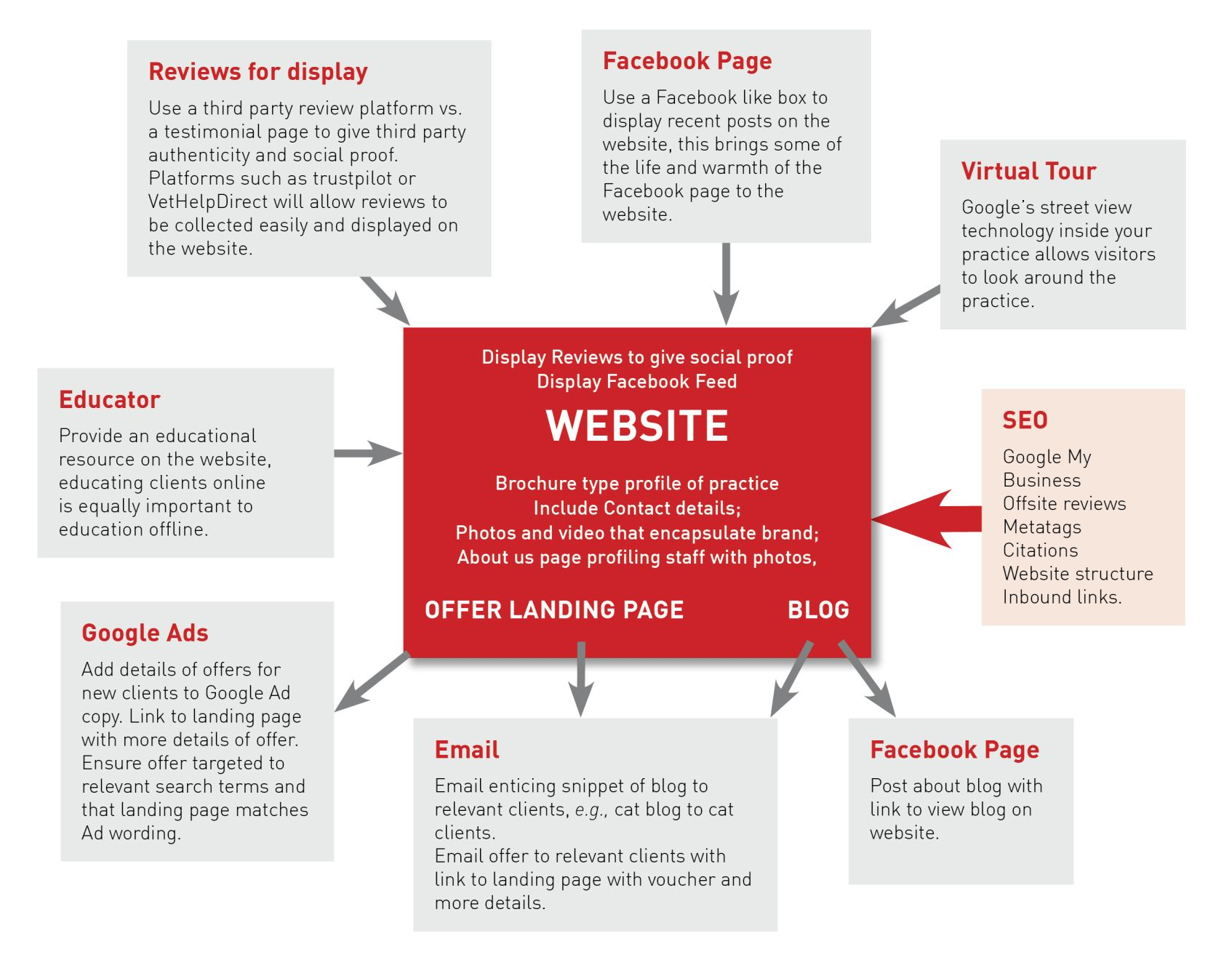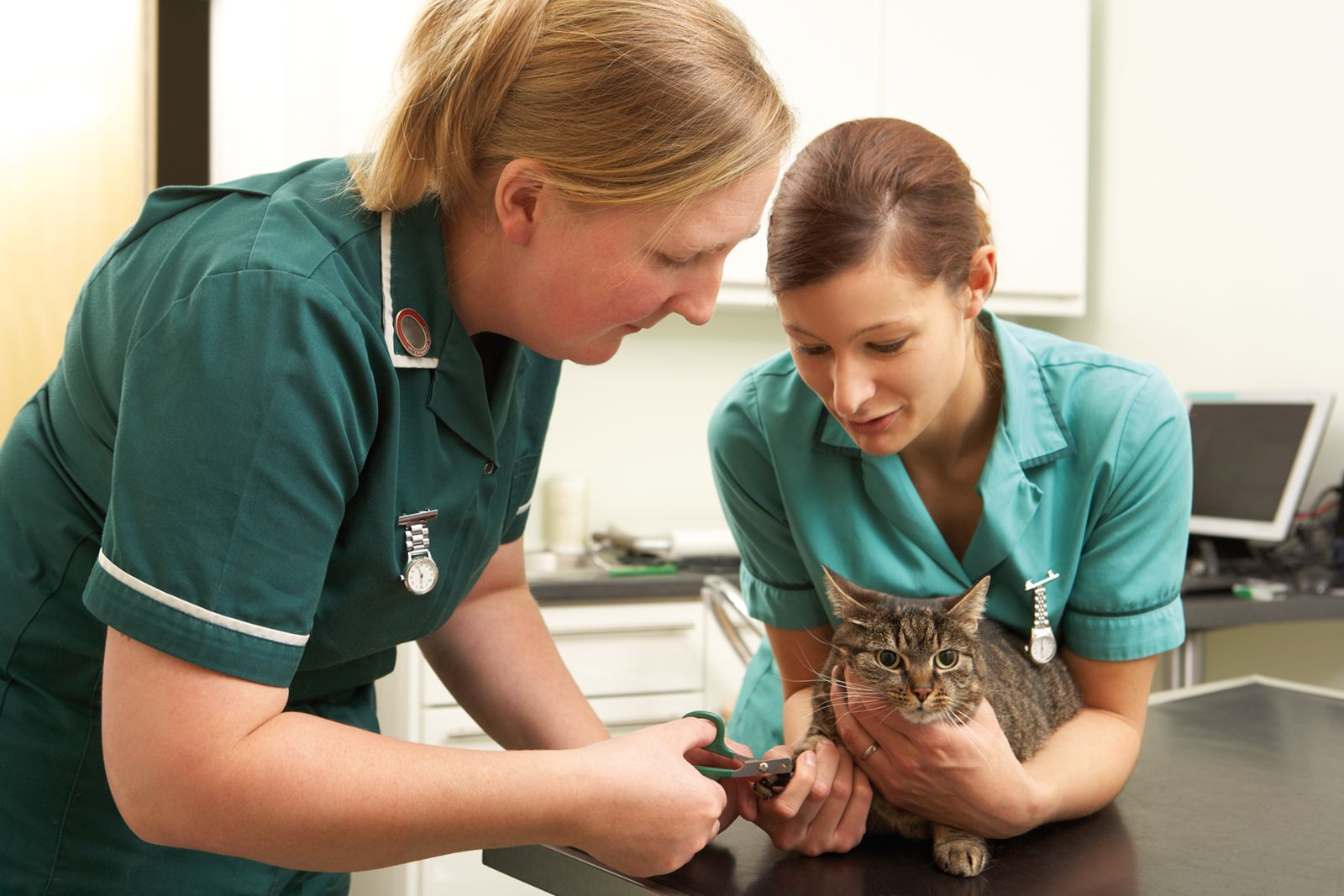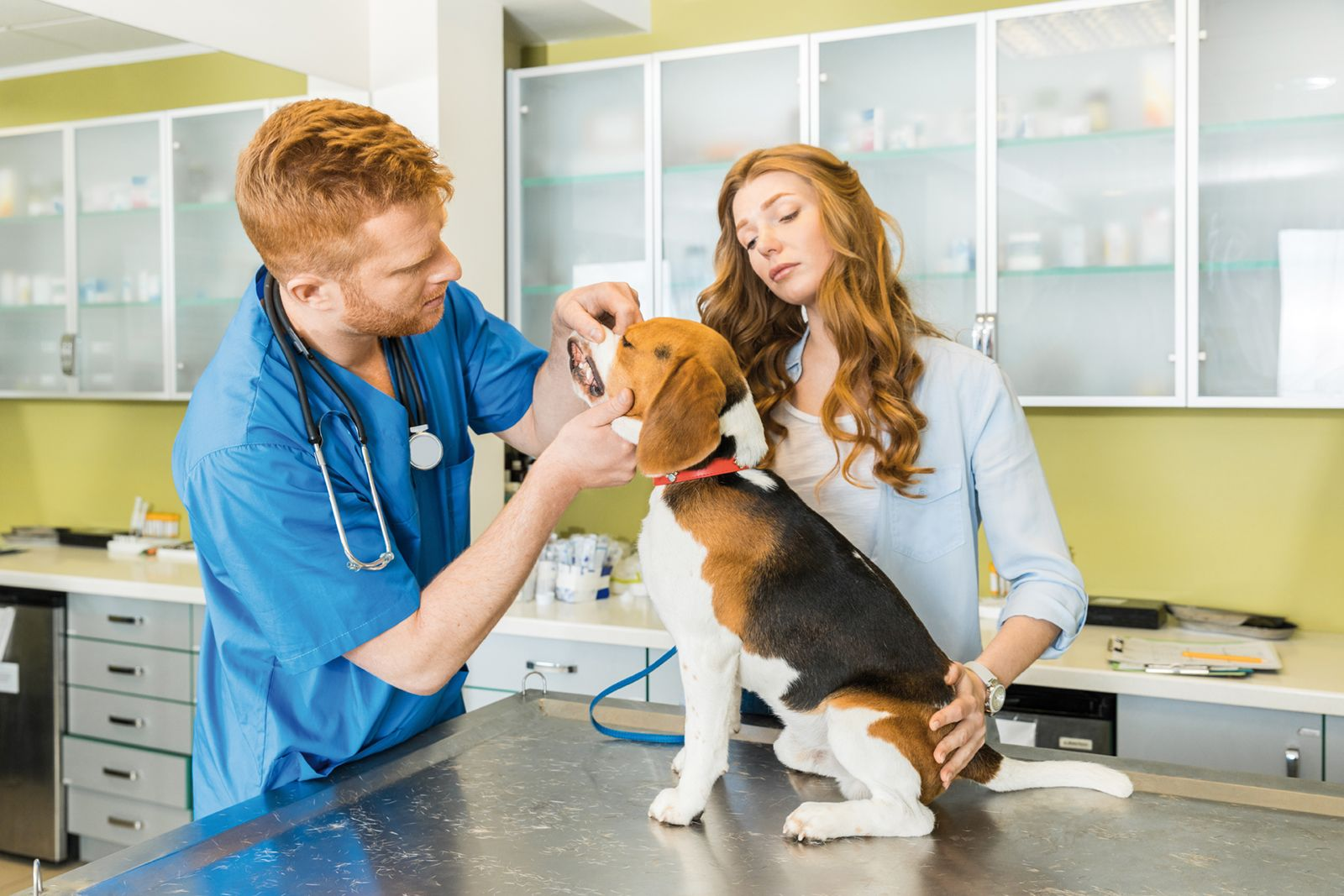Strategy and tools
This chapter will give you practical tips (what to do, what not to do, main pitfalls, etc.) on blogs, websites and social media and how to encourage clients to leave positive reviews on the web, with the goal of creating synergy between the different tools. We will also outline general considerations about communication including branding and consistency.

Key Points
To be effective, your online communication should consider the different “personas” of your clients.
At the first visit of a puppy or kitten, it is important to give an overview of the veterinary needs during the whole life of the pet.
The communication of the practice will be more efficient if the messages are consistent across all platforms.
Webmarketing strategy
The first step in developing an Internet marketing strategy is to understand the audience, How old are they? What Gender? Are they professionals? Do they have families or are they retired? Which types of pets do they own? How old are those pets? Some of this data can be found in the Practice Management System (PMS) however information such as owner age and status is unlikely to be available, Facebook provides detailed demographic information about the page’s audience but often it is worth running a client survey to find out more details about the likes, dislikes, and demographics of your clients. Bear in mind that the demographic of people you wish to target to become new clients may be different to your existing client base. “Personas” are a useful tool used in Internet marketing to visualise these statistics. They are fictional people chosen to represent a large section of the client base, this is not a scientific process and not everyone will be represented however they are a very useful tool.
“Personas” (Figure 1) can be used across the Internet marketing strategy, for example, to test a website. “Would Maxime be looking at the website on his mobile?”, they can also be used to design promotions, e.g., “How could we reach Maureen to explain the importance of a dental check for her cat?”


Establishing the aims of the Internet marketing strategy and the Key Performance Indicators (KPIs) to measure performance is the next step (Figure 2). The beauty of Internet marketing is that it can be measured; success can be quantified and rapid feedback can be provided as to what is working and what is not. High level KPIs such as New Client Acquisition are affected by too many other factors to be useful as the sole measure for the success of an Internet marketing campaign, these top level KPIs can be translated into a series of more focused KPIs which are more useful for day-to-day management of digital marketing. If these low level KPIs improve the top level ones will improve alongside this.

Examples of Top Level KPIS (New Client Acquisition) translated into Digital KPIs
• New Visitors to website (Google Analytics)
• Number of Likes on Facebook Page (Facebook Insights)
• Reach of Facebook Page (Facebook Insights)
• Google My Business Insights Views (Google My Business)
• Number of online reviews generated/month
• Online client experience
• Time on Site (Google Analytics)
• Facebook Page Engagement (Facebook Insights)
• Open Rate of Emails (Email Marketing Platform)
• Click through Rate Emails (Email Marketing Platform)
Brand
The “Brand” is the designs, communication style, vision and values that identifies the practice and differentiates it from others. The brand should be consistent in all communications and across all platforms.
Brand — areas to define
• Mission statement — a short statement summarising the practice’s purpose and the service it hopes to achieve
• Strapline — a short slogan that encapsulates the practice’s values
• Logo
• Font
• Colours and shapes
• Tone of voice — e.g., Friendly, Professional, Informal etc.
Communications calendar
The messages that you communicate via Internet marketing will be more effective if they are used across all platforms, a communications calendar will help to achieve this.
Typical monthly calendar
| July | |
|---|---|
| Call to action | Come in for dental check |
| Key messages | Signs of dental disease, how to brush |
| Blog |
Dental, what’s involved
Before after comparison
|
| Blog, stimulate conversation in community about tooth brushing, signs of dental problems | |
| Free dental check | |
| Video | Video showing how to check dog’s mouth for signs of dental problems |
This level of planning also makes it easier to keep your Internet marketing strategy running when the practice is experiencing busy times or there are staff changes. The communications calendar should have themes or promotion headings for each month and then details of how this will be executed differently across each platform.
Multichannel marketing
The website, social media, search and paid ads work most effectively together, this is known as “Multichannel Marketing”. The brand and the communications calendar are the tools to achieve this and the website is an essential part of this as it acts as the hub of the multichannel marketing strategy. Content can be posted either on the blog of the website, or an especially designed landing page, this can then be linked to via social media, email and paid ads.
For example, a promotion around free dental checks for cats could centre around a blog on dental issues in cats, discussing the difficulty of knowing if a cat was in pain; a case story and photos might give this a more engaging edge. A post could then be written on Facebook with a key message from the blog and linking to the blog on the website for more information. A photo from the blog could be posted on Instagram with appropriate hashtags, an email could be sent out to cat owners only with an engaging title and a link to the blog. A landing page would be created on the website with a downloadable voucher for a free dental check for owners to take in to the vets or share with a friend. A post about the offer could be made on Facebook with a link to the landing page; further posts could be written throughout the month profiling cats that have been in for the free dental check. Paid ads could be used on Facebook to ensure that the maximum number of people see the voucher and Google paid ads could be amended to profile the free dental check, these would be set up to show if anyone searches for information on cats teeth or “cat vet”. The blog and voucher should also assist with Search Engine Optimisation as websites may link to the page if they perceive the content to be valuable.
The brand and the branding
When vets practised alone, they did not need a brand, or more precisely, their only brand was their own name. Now that they practise mostly in teams and increasingly often in large teams, the brand of the clinic and its various attributes constitute a major tool. The brand, often associated with a logo, whose conditions of use are defined in a graphic chart, creates an identity under which clients will know the clinic and recognise it from others. With the development of large groups of clinics and intense marketing, the level of exposure to brands has grown in the veterinary sector and it is important that independent clinics or local clusters are not left behind.
This is not the place to detail the recommendations for choosing a brand and an identity, but it is clear that the client experience is optimised by systematic and consistent use of that brand and identity, called “branding”. The objective here is to maximise the exposure of the client to the brand, within a consistent framework and in accordance with the charter that the clinic has established. Specifically:
• Developing a brand and an identity has a value. For example, if it is important for clients to identify the name of the vet, nurse or receptionist they have previously dealt with, this identification should not be at the expense of the clinic. All the communication media (badges, prescriptions, signatures, etc.) will therefore indicate the name of the person whilst recalling the identity of the clinic.
• In general, the name of the clinic and its logo will be consistently present on all the communication tools, but also on signs used by the clinics: outside the premises (signage, plaque, insignia, etc.), to inside the premises (on a wall, on the furniture, on the elements of interior signage, etc.), on all the documents (leaflets, prescriptions, estimates, invoices, etc.), badges, uniform and vehicles (especially if the vets conduct outpatient care). Each of these appearances of the graphic and the logo will of course conform to the brand guidelines (hence the importance of providing a colour version and a black and white version).
• Branding extends to different media: website, Facebook page, email signatures. This includes telephone communications, whether an incoming call (which will ensure that all people answering a call correctly mention the name of the clinic), or pre-recorded messages, such as call-waiting messages or answering machine messages. If the clinic posts messages in the reception or waiting area, in a paper or video format, a format that integrates the visual identity of the clinic is always preferable to another that has only that of a third party, for example a partner supplier.
As is often the case, a systematic, discreet, consistent and tasteful presence is better than disparate, inconsistent and/or ostentatious elements.
How to better use your PMS
Most veterinary practices do not get everything they can out of their management programmes. The most used feature among clinics is the “point-of-sale terminal”, i.e., recording transactions for both services and products made with clients, for both payment and cash control purposes as well as for calculating tax obligations. Another part of the PMS that veterinarians are accustomed to using on a regular basis is that of client and patient records, where they record the key medical and administrative information. It is also common for clinics to use the vaccination reminder function, automating personalised notifications to clients, reminding them that they need to bring their pets in for revaccination.
However, there is another whole set of other “good practices” related to the usage of PMS that is not commonly present in many veterinary practices. Some examples are:
• Periodically recording patients’ body condition and dental condition. Unless we do this, how can we know whether or not we have already discussed these issues with our clients?
• Systematically recording in the patients’ clinical records or file whenever a recommended treatment is refused or postponed. Failure to do so makes us lose future sales opportunities and can cause frustration and a perception of disinterest in clients, by repeatedly offering them things that we have already discussed with them in the past.
• Identifying all transactions made with clients and patients. Sometimes in over-the-counter transactions (in the area of product sales), with the intention of speeding up the process, a fictitious client is created. This client is named “various clients” or “over-the-counter sales”, and most over the counter sales are indiscriminately attributed to him/her. The result of this habit is that we lose valuable information about our clients’ buying behaviour (when they came, what they purchased). Also, it can distort important KPI’s such as active patient count or annual spending per patient.
• Consistently filling in the diagnostic fields associated with visits/cases, ideally with a standardised list of terms. Without this, we lose the opportunity to ascertain the prevalence of various diseases and conditions at our centre (per 1,000 visits) in order to detect possible diagnostic gaps. We also lose the opportunity to generate patient lists classified by diagnostic groups, which can be very useful in creating segmented communications, offering them specific services or products, etc.
• Producing task lists, such as vaccination or de-worming reminder calls, specialist appointment reminder calls, post-surgery calls, etc. Most management programmes allow for automated reminders to be customised and associated with specific task lists. Many veterinarians have the misconception that the “reminder” feature of their PMS is only useful for generating vaccination reminders… this severely limits the use of reminders. Reminders are useful for every preventive care service (including neutering or dental cleaning) as well as products (flea and tick, wormer...) and with chronic disease follow-up (osteoarthritis, atopy, cardiology...).
Is there an optimal ratio?
The proportion between vets and support staff (assistants, receptionists, administrative staff) varies considerably in various countries around the world.
In countries where there is a relative undersupply of veterinarians, it is common to find high support staff to vet ratios (3:1, 4:1). This is a result of the economic logic of optimising the company’s most costly resource: if a veterinarian costs 3-4 times more than an assistant, it makes sense for the veterinarian to focus on tasks that generate his/ her centre’s most financial and professional value: diagnosis, complex clinical procedures and treatments offered to clients. Meanwhile, support staff focus on related tasks, freeing up time for the veterinarian: welcoming clients, taking medical histories, simple tests, returning telephone calls, etc.
In contrast, in countries where there is an oversupply of vets, the opposite occurs. As it is just as costly (or, unfortunately, sometimes even less costly) to hire a young vet than a well-trained assistant, ratios of support staff to vets substantially decline or are sometimes even reversed (it is not uncommon to come across clinics with 4-5 vets, 1 assistant and 1 receptionist). Obviously, in these countries, the vets end up doing practically all tasks at the centre (both clinical and non-clinical tasks) (Figure 3).

That said, there is no empirical evidence that one model necessarily results in a better or worse client experience over another. In all these countries, we come across clinics that love their clients, as well as clinics that drive them away, regardless of their ratios between various staff profiles. The type of model is more a result of the economic structure of these markets than a planned decision made by the owner of the veterinary practice. What is clear is that both models present very different management challenges:
• In the “undersupply of vets model” (few veterinarians very well supported), the key is that the client does not perceive the vet as a distant, overly busy professional, who is very task-focused (case-focused) but not so relationship-focused (client- and patient-focused).
• High value client interactions that should be managed by the vet, no matter how costly is her/his time:
- Presenting estimates for complex (expensive) procedures
- Communicating the findings of important tests
- Asking the owner for permission to change a previously agreed treatment plan
- Recommending to the owner referral to a specialist
- Communicating a negative unexpected outcome of a medical procedure
• In the “oversupply of vets”, (multipurpose veterinarian who interacts intensely with the client as he/she personally deals with almost all tasks) the challenge involves getting the client to maintain their professional respect for and give credibility to the vet. It is not easy to convince a client that the same vet who opens the door, answers the telephone, charges you at the desk and collects your cat’s excrement is, at the same time, a reputable surgeon within the industry.
Take the long view in client relations
General veterinary clinics cannot grow based solely on occasional relationships: a client takes his pet to the clinic, the clinic looks after it, the client leaves satisfied after a superb experience. It is best that the first opinion veterinary surgeon is active over the long term, throughout the lifetime of the animal (Box 1).
|
A specific case : the “3-r” technique. American consultant Tom Catanzaro [1] popularised the so-called “3-R” rule. The central idea is that the clinic must always take the initiative in client relationships and pro-actively propose the next contact.
Recall — Recheck — ReminderCatanzaro argued that, if at one given point we were to analyse all client records at a clinic, those for which none of these three actions are scheduled (recall, recheck, reminder) are likely to be lost… That is, if we as veterinarians do not decide when we want to contact a client again (to tell them something by telephone, to review their pet or to remind them of the need to follow a preventive treatment), the client will likely forget to do so.
|
To achieve this objective, the task of managing the client’s experience cannot be limited to optimising each contact; it is also important to give the client perspective over time and a proven benefit so that he returns to the same clinic for all the needs relating to the health of his or her animal.
It is possible to separate a pet owner’s experience of veterinary care into three categories: preventive medicine, general medicine and surgery, and specialised services, in which we include emergencies.
Preventive medicine offers an opportunity to integrate the health care of the animal over time. It consists of a succession of sequentially programmed services which make up a chain of care adapted to the different stages of life of the animal: paediatrics (Figure 4), puberty, young adult, senior animal and geriatrics. The process of preventive medicine is by nature very loyalty-inducing and allows the vet to create a positive experience for the client by describing the preventive care offering of the clinic and by organising the sequence of the various services. Two methods can be used to improve the client’s experience in prevention.

Preventive medicine offers an opportunity to integrate the health care of the animal over time.
• The traditional approach is to sell services one after the other, with a relatively short-term perspective. The clinic’s job is thus to ensure that each service is well prescribed at the end of the previous one, in the form of a “presentation of the next step, its objectives and its content” and then a reminder of this next step two to three weeks before the deadline by post (less and less frequently), e-mail or SMS. For example, at the end of the final paediatric consultation of a puppy, the vet will prescribe, depending on his preventive medicine offer, pubertal consultation or neutering or the first annual health examination. In each of these three cases, the vet will offer the client a reminder to help them avoid missing the deadline, which would be detrimental to his pet. Even, in this traditional approach, veterinary clinics should offer a global view on the course of prevention throughout the pet’s life, for instance a leaflet given to pet owners the first time they come to the practice. Furthermore, the practice’s team should also follow up on the message of the same leaflet at every point in the prevention pathway: e.g., during the first young adult annual health check or the first senior pet annual health check.
• The development of prevention plans consists of commercialising service packages (and some products, in particular parasite control products), covering the animal’s prevention needs over a period of time, generally one year, paid most often by monthly bank withdrawals. This technique allows clinics whose preventive medicine services are at a high level to increase client loyalty by providing their animals with an optimal level of prevention for a predictable, monthly budget. This method of marketing preventive medicine also creates a positive client experience by demonstrating that the clinic is making every effort to improve the health of the animal. Nevertheless, there’s still a need to offer a broader perspective of prevention throughout the pet’s life, for instance by introducing the different wellness plans offered in the clinic according to pet’s life stage (junior, young adult, senior). Diseases or accidents are one-time and unpredictable events and it is difficult to optimise the client experience by translating it to a long-term basis. However, it is possible to do this in two ways: when a case needs not only a one-shot consultation but also a consultation and one or several re-checks, and simply by keeping the animal’s health history thus positioning oneself as a family vet who actually knows this animal.
• The follow-up of the cases in progress is of great operational importance to ensure the success of the work of the clinic’s team. It is based on the continuity of care, either with the same practitioner or with several vets of the team, but always through an exhaustive sharing of the relevant information, using the medical record on the practice management system (PMS) (Figure 5). All PMS systems offer programmes that include this feature, but all team members must be trained in its use and instructed on the information to be included in the animal’s record. If it is up to the owner to relay between two vets by explaining to the second what was said or done first, the clinic runs a great risk of damaging the client’s experience and creates the impression there would have been no more difficulty if they had gone to two different clinics. On the other hand, if the animal’s information is efficiently distributed to the team and each vet can understand the history, then the owner will see the advantage in deepening his relationship with the clinic.
• This observation can be generalised to all contact between the clinic, from a preventive medicine service to when the animal is sick or injured, consider a simple purchase at the counter, pet food for example. It is vital that the client reflects on every time he is well not just in any veterinary clinic but in his clinic, that is to say the one that knows his animal. This is achieved by consulting the animal’s record before each consultation in order to bring up a point in the animal’s medical history with the owner: “How did the bronchitis in February resolve?” Or “We recommended a dental cleaning last year, have you thought about the matter?” Or “I see that Fluffy has put on two kilos since last year...” Similarly, at the end of the consultation, summarising the main points and logging them in the medical file in a very obvious way shows the client the benefits of follow-up over time.

Finally, specialised services are most often referred to a clinic or hospital that will provide them directly, so it is difficult to see how the general practice could enhance the client experience at that time. However, even though it does not provide these specialised services itself, there are opportunities to strengthen its relationship with its clients. Specifically, if the referral process is conducted by the first opinion clinic — good choice of specialist, transmission of medical information, management of the follow-up coordinated with the specialist, etc. — it is to the first opinion vet that the owner will show satisfaction and gratitude! This also applies emergencies requiring critical care or simple services but to be provided outside the normal opening hours of the first opinion clinic. Once again, if the solution suggested by the clinic is of high quality and the coordination between the general practitioner and the emergency centre goes well, it is the former who will benefit from the recognition from the client.
On the balance sheet, we can see that the first opinion clinic can provide its clients with all their health care needs, most of which are treated internally and some are referred to specialists, but always at the initiative and under the auspices of the “family vet”. Providing a lifelong perspective of medical follow-through represent an important dimension of customer experience improvement.
Managing complaints
Face-to-face management
Even if you are a magician in communicating with your clients, there will always be somebody, that feels unfairly treated, misunderstood, disrespected or in any other way not happy (Figure 6). Don´t worry — that´s human, there just isn´t a “one size fits all“ way of communicating that prevents negative emotions.

Here is a standard procedure on how to address difficult situations with clients:
• Hear your client out and focus on listening, don´t interrupt till the end (you may take notes).
• Express understanding by saying: “I can understand that you are angry (disappointed, unhappy etc.). If that would have happened to me, I would also be angry!“
• Take control: “I suggest, we sit down and sort out what has happened and find a solution, OK?”
- If the client is on the phone, try to get him to the office to talk eye-to-eye, that´s always better than on the phone.
• Move the client to a separate room without audience to analyse the situation.
• Take time, sit down and investigate the matter and find out what went wrong.
- If the client has been angry without reason, the matter is already resolved.
- If it turns out to be the practice´s fault: apologise and give a little present.
Never take complaints personally! Think: “It´s not about me. Something went wrong and now
I get the chance to set it right.“ Most of the difficult situations that occur in every day practice are based on misunderstandings because of unclear communications. If you feel you have a lot of “events” with unhappy clients, maybe it´s time to take a closer look at how your client communication is set up and how to improve it.
Dealing with negative comments online
If you run a veterinary practice you will at some point in time become the victim of negative comments online. This can be very upsetting for staff and owners alike and it is essential to have a policy in place before this happens so that staff are ready to deal with the problem in a calm and non-emotional way. Useful feedback can be garnered from some negative reviews, and where the negative comment is reasonable and not offensive it its worth handling as openly and transparently as possible. Often a negative situation can be transformed into a positive one by showing that you care enough to respond and take action.
Straightforward problems
• Deal with the problem as quickly as possible.
• Respond publicly where appropriate.
Constructive criticism
• Remember to thank the client for the suggestion.
• Listen to the perceived problem.
• Act if appropriate and keep the client updated on the page.
• If it is not appropriate to act or change your procedure explain why.
Reasonable complaint
• Remember to thank them for bringing the issue to your attention.
• Be positive, avoid linking negative words and comments to your name.
• Describe steps being taken to rectify the problem.
• You may find that loyal clients leap to your defence, after all within social networking pages, these are your “fans” and “followers”
Unreasonable complaints, unconstructive criticism or spam postings
• If possible contact the client privately.
• If the comment is on your Facebook fan page delete it as quickly as possible.
• Do not respond publicly on Twitter. Use a private “Direct Message” or contact the client through traditional media.
• Ask the client not to post any similar comments.
If you need to take further action you can
• Ban people from posting on your practice’s Facebook fan page (instructions below).
• “Report” them on Facebook pages outside your control.
• Click “Report” under their post.
• Block them from following you on Twitter, although they can still mention you they can’t read your tweets.
• If you believe that a comment on an external website is defamatory you can complain to the website containing the comment.
• If you are not satisfied with the response from an external website you can complain to their Internet Service Provider (ISP). Find out who this is using WhoIS register http://www.whois.net . ISPs will often close sites down or ask them to remove information to avoid legal action against themselves.
Managing comments/banning users
• If you want to delete a comment that has been left on a post on your page, hover over the comment and click the “x” (hide). From there a small menu will appear, you can delete the post, report the post or ban the user from your page.
• If somebody has posted a comment on your wall (which can be found in the “visitor posts” box on the right of your page below the cover photo) that you wish to remove, hover over the post and click “x” and then click “delete” or “report/mark as spam.”
The importance of consistency
As we have seen, in order to improve the client experience, the clinic will undertake a large number of actions in different areas, edit documents, use different media and introduce many procedures or protocols. In real life, it is important not to lose sight of the importance of the consistency between all these elements and the actual behaviour of the different members of the team.
To put it simply, one of the effects of communication is to strengthen the expectations of clients. However, satisfaction is a feeling that results from the perceived gap between expectations and the actual delivery. In other words, whenever the client’s experience is improved, the expectations are reinforced for the next time. Obviously, this is not to conclude that we must be satisfied with mediocre performance so as not to risk disappointment next time!
The main take away from this requirement of consistency is that when something is promised, that promise must be kept. So it is a question of promising only what one is able to deliver in the long term, while aiming for a high standard. It is useful to keep some common errors in mind:
• When a clinic has just opened and its activity is still limited, or if the load is reduced on a given day, the team may tend to devote a lot of time to each client. This may improve the experience of clients who come at this time, but if one is unable to maintain this level of performance when the activity increases or is simply “normal”, the initial benefit can quickly change into dissatisfaction.
• Likewise, statements that aim high about the company’s vision, mission or values are helpful only if they are effectively verified in everyday life, otherwise they can backfire. It is therefore important to pay particular attention to the on-boarding of new employees — whether a receptionist, nurse or vet — through initial training and close coaching when they join the team to ensure that they meet the requirements that the clinic has set.
• Generally speaking, one communicates much more than one believes, through behaviour (punctuality, order, clarity, etc.), through day-to-day documentation (an estimate or an invoice can have much more impact than a professionally produced leaflet), by the state of maintenance, cleanliness of the premises or the absence of bad odour.
Finally, the most serious inconsistencies are those that affect the messages of different team members to the same client: such as a receptionist who explains the price to pay for several minutes before a vet, or even the owner of the clinic, grants a “one-time” discount; a vet who prescribes quarterly deworming to an animal while his partner explains that “twice a year”, that should be enough...
Conclusion
|
It is suggested that an agency specialized in veterinary digital communication is used to assist your website and social media. Practice Management Software (PMS) offer more and more options for communicating with your clients. Finally, the two most important points are to be consistent in your communication with the clients, and for owners of kitten or puppy, to give them a long-term view of the veterinary services they will benefit from during their life. |
References
- Thomas E. Catanzaro, Thom Haig, Peter Weinstein, Judi Leake, Heather Howell. Veterinary Healthcare Services: Options in Delivery. August 2000, Wiley-Blackwell
Pere Mercader
DVM, MBASpain
Dr. Mercader established himself as a practice management consultant to veterinary clinics in 2001 and since then has developed this role in Spain, Portugal and some Latin-American countries. His main accomplishments include authoring profitability and pricing research studies involving Spanish veterinary clinics, lecturing on practice management in more than 30 countries, and authoring the textbook “Management Solutions for Veterinary Practices” which is published in Spanish, English and Chinese and has sold worldwide. In 2008, he co-founded VMS (Veterinary Management Studies), a business intelligence firm that provides a benchmarking service for more than 800 Spanish veterinary practices. Dr. Mercader was also a co-founder of the Spanish Veterinary Practice Management Association (AGESVET) and served on its board for eight years.
Philippe Baralon
DVM, MBAFrance
Dr. Baralon graduated from the École Nationale Vétérinaire of Toulouse, France in 1984 and went on to study Economics (Master of Economics, Toulouse, 1985) and Business Administration (MBA, HEC-Paris 1990). He founded his own consulting group, Phylum, in 1990 and remains one of its partners to this day, acting primarily as a management consultant for veterinary practices in 30 countries worldwide. His main areas of specialization are strategy, marketing and finance, and he is also involved in training veterinarians and support staff in the field of practice management through lectures and workshop, as well as benchmarking the economics of veterinary medicine in different parts of the world. A prolific author, he has authored more than 50 articles on veterinary practice management.
Antje Blattner
DVMGermany
Dr. Blaettner grew up in South Africa and Germany and graduated in 1988 after studying Veterinary Medicine in Berlin and Munich. She started and ran her own small animal practice before undertaking postgraduate training and coaching course at the University of Linz, Austria and then founded “Vetkom”. The company provides training to veterinarians and veterinary nurses in practice management in subjects such as customer communication, marketing and other management topics. Dr. Blaettner also is editor for two professional journals, “Teamkonkret” (for veterinary nurses) and “Veterinärspiegel” (for veterinarians).
Susie Samuel
MA, VetMB, MRCVSUnited Kingdom
Dr. Samuel graduated from Cambridge University in 2001 and spent ten years working in both mixed and small animal practices. In 2006 she set up VetHelpDirect.com, a website that helps owners decide how quickly they need to seek veterinary attention for their pets. The business quickly evolved to become a specialist veterinary Internet marketing agency, winning the 2015 Veterinary Marketing Award for Practice Marketing, and Dr. Samuel eventually left practice to become managing director of the company. She also holds the Google Certificate in Internet Marketing, and trains veterinary staff in all aspects of Internet marketing.
Other articles in this issue
Share on social media